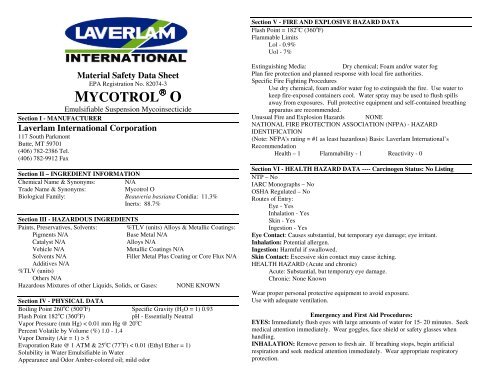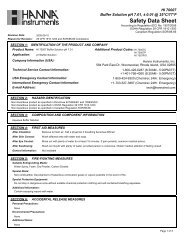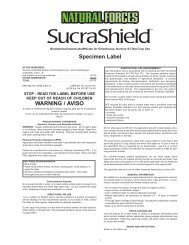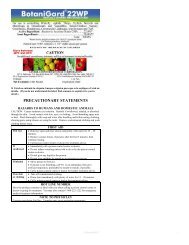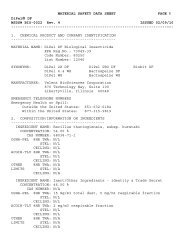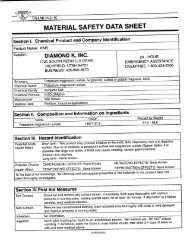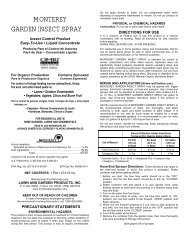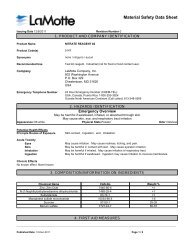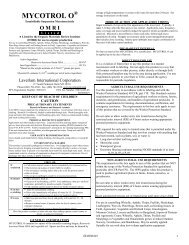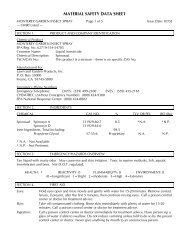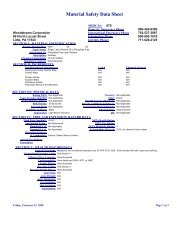Mycotrol O MSDS - Arbico Organics
Mycotrol O MSDS - Arbico Organics
Mycotrol O MSDS - Arbico Organics
- No tags were found...
Create successful ePaper yourself
Turn your PDF publications into a flip-book with our unique Google optimized e-Paper software.
Section V - FIRE AND EXPLOSIVE HAZARD DATAFlash Point = 182 o C (360 o F)Flammable LimitsLol - 0.9%Uol - 7%Material Safety Data SheetEPA Registration No. 82074-3MYCOTROL ® OEmulsifiable Suspension MycoinsecticideSection I - MANUFACTURERLaverlam International Corporation117 South ParkmontButte, MT 59701(406) 782-2386 Tel.(406) 782-9912 FaxSection II – INGREDIENT INFORMATIONChemical Name & Synonyms: N/ATrade Name & Synonyms: <strong>Mycotrol</strong> OBiological Family: Beauveria bassiana Conidia: 11.3%Inerts: 88.7%Section III - HAZARDOUS INGREDIENTSPaints, Preservatives, Solvents: %TLV (units) Alloys & Metallic Coatings:Pigments N/A Base Metal N/ACatalyst N/A Alloys N/AVehicle N/A Metallic Coatings N/ASolvents N/A Filler Metal Plus Coating or Core Flux N/AAdditives N/A%TLV (units)Others N/AHazardous Mixtures of other Liquids, Solids, or Gases: NONE KNOWNSection IV - PHYSICAL DATABoiling Point 260 o C (500 o F) Specific Gravity (H 2 O = 1) 0.93Flash Point 182 o C (360 o F) pH - Essentially NeutralVapor Pressure (mm Hg) < 0.01 mm Hg @ 20 o CPercent Volatile by Volume (%) 1.0 - 1.4Vapor Density (Air = 1) > 5Evaporation Rate @ 1 ATM & 25 o C (77 o F) < 0.01 (Ethyl Ether = 1)Solubility in Water Emulsifiable in WaterAppearance and Odor Amber-colored oil; mild odorExtinguishing Media: Dry chemical; Foam and/or water fogPlan fire protection and planned response with local fire authorities.Specific Fire Fighting ProceduresUse dry chemical, foam and/or water fog to extinguish the fire. Use water tokeep fire-exposed containers cool. Water spray may be used to flush spillsaway from exposures. Full protective equipment and self-contained breathingapparatus are recommended.Unusual Fire and Explosion Hazards NONENATIONAL FIRE PROTECTION ASSOCIATION (NFPA) - HAZARDIDENTIFICATION(Note: NFPA's rating = #1 as least hazardous) Basis: Laverlam International’sRecommendationHealth – 1 Flammability - 1 Reactivity - 0Section VI - HEALTH HAZARD DATA ---- Carcinogen Status: No ListingNTP – NoIARC Monographs – NoOSHA Regulated – NoRoutes of Entry:Eye - YesInhalation - YesSkin - YesIngestion - YesEye Contact: Causes substantial, but temporary eye damage; eye irritant.Inhalation: Potential allergen.Ingestion: Harmful if swallowed.Skin Contact: Excessive skin contact may cause itching.HEALTH HAZARD (Acute and chronic)Acute: Substantial, but temporary eye damage.Chronic: None KnownWear proper personal protective equipment to avoid exposure.Use with adequate ventilation.Emergency and First Aid Procedures:EYES: Immediately flush eyes with large amounts of water for 15- 20 minutes. Seekmedical attention immediately. Wear goggles, face shield or safety glasses whenhandling.INHALATION: Remove person to fresh air. If breathing stops, begin artificialrespiration and seek medical attention immediately. Wear appropriate respiratoryprotection.
INGESTION: If swallowed, give several large glasses of water to dilute. Do notinduce vomiting.SKIN CONTACT: Immediately flush with large amounts of water for 15-20 minutes.If irritation continues, seek medical attention. Wear waterproof gloves.MEDICAL CONDITIONS GENERALLY AGGRAVATED BY EXPOSURE: NONESection VII - REACTIVITY DATAStability: Stable Compound. This product is stable and will not react violently withwater.Incompatibility (Materials to Avoid): Avoid contact with strong oxidants such asliquid chlorine, concentrated oxygen, sodium hypochlorite, calcium hypochlorite, etc.,as this may present an explosion hazard.Hazardous Decomposition Products: CO xHazardous Polymerization will not occur.Section VIII - ENVIRONMENTAL DATAThis product contains an oil and as such, may be classified under Section 311 of theClean Water Act and/or under the Oil Pollution Act.Spills into or near waterways resulting in a sheen must be reported to the NationalResponse Center (1-800-424-8802).Steps to be Taken in Case Material is Released or SpilledWear protective equipment including waterproof gloves, coveralls over long-sleevedshirt, long pants and a NIOSH/MSHA approved respirator for organic vapors. Wearchemical goggles if a half-face mask respirator is worn. For small spills, sweep upand dispose of in a D.O.T. approved waste container. For large spills, place intoD.O.T. approved waste container. Keep out of sewers, storm drains, surface watersand soil. Comply with all applicable Federal, State and local requirements on spillreporting, handling and waste disposal. Water wash with strong detergent or wettingagent; Non-Toxic. Absorb with inert material (sand, earth or other absorbent.)Minimize skin contact.Waste Disposal Method: Landfill approvedD.O.T- approved container for disposal.Dispose of contaminated product and materials used in cleaning up spills or leaks in amanner approved for this material. Consult appropriate Federal, State and localregulatory agencies to ascertain proper disposal procedures.NOTE: Empty containers can have residues and mists and are subject to proper wastedisposal as above.Not Applicable - XXXOther Precautions:Potentially pathogenic to honey bees. Avoid applying to areas where honey bees areactively foraging or around bee hives. This product may be toxic to fish.Section IX - SPECIAL PROTECTION & PRECAUTIONSRespiratory Protection: Use with adequate ventilation. Use with NIOSH/MSHAapproved respirator for organic vapors. If half-face mask is worn, chemical safetygoggles should also be worn.Ventilation System: A system of local and/or general exhaust is recommended tokeep employee exposure to a minimum.Skin Protection: Wear waterproof gloves, safety shoes, long-sleeved shirt and longpants.Eye Protection: Use chemical safety goggles. Contact lenses should not be wornwhen working with this material. Maintain an eye wash fountain and quick drenchfacilities in work area.Other Protective Equipment: Coveralls over long-sleeved shirt and long pants;shoes plus socks.Work Hygienic Practices: Wash thoroughly after handling. Minimize rubbing ofeyes. Remove contaminated clothing; launder or dry clean.CONTAINER DISPOSAL: Do not reuse as a container. Triple rinse (or equivalent).Then offer for recycling or reconditioning, or puncture and dispose of in a sanitarylandfill, or by other procedures approved by state and local authorities.Section X - TRANSPORTATION AND OSHA LABEL INFORMATIONU.S. DOT HAZARDOUS MATERIALS SHIPPING DESCRIPTION: Not RegulatedNOTE: Product label may contain non-OSHA related information also.TRANSPORTATION INCIDENT ADVISORY: For additional information, refer tothe latest DOT Emergency Response guidebook.LAVERLAM INTERNATIONAL CORPORATION believes the information andrecommendations contained herein are accurate and reliable as of the date issued.Buyers and handlers of this product shall assume all risk and responsibility forpotential loss or damage if this product is used, stored, handled or applied in a mannerinconsistent with its registered labeling. To the extent permitted by law, manufacturershall not be liable for more than the purchase price or the quantity involved includingincidental, consequential or special damages.For an <strong>MSDS</strong> or assistance with an <strong>MSDS</strong>, direct inquiries to the address on the front.Date Revised: 2/21/11EPA Hazard Classification CodeAcute - HazardChronic - HazardFire - HazardPressure - HazardReactive - Hazard


